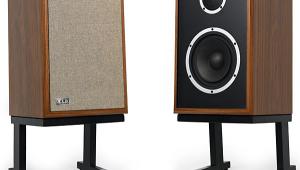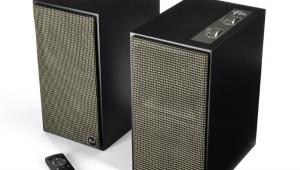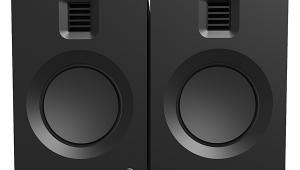Mirage MX 5.1 home theater speaker system

The MX 5.1's five identical satellites are about the size of those half-pint milk cartons we used to get with saltines before rest period, while the Honey I Shrunk the Subwoofer that accompanies them is a mere 8-inch cube. The whole shebang arrives in a single carton no larger or heavier than a typical bookshelf speaker -- this baby is small.
The MX satellites are the latest (and tiniest) examples of Mirage's signature Omnipolar design, which in this case combines a small cone midrange driver firing upward with a tiny tweeter suspended above it. Each driver interacts with a deflector that nudges its acoustical output into a more omnidirectional pattern. Mirage claims that this arrangement closely mirrors the 30/70 direct-to-reflected sound ratio of live music and delivers excellent imaging width and depth regardless of listener position.
The MM-6 sub is a more conventional design, but still has some unusual features besides its nearly comical dimensions. Its three 61?2-inch cones are all made of aluminum. Only one of them is active, while the remaining two serve as passive radiators, functioning much like a tuned port. Harnessed to a built-in amplifier with a claimed 800-watt output, they deliver bass reproduction that Mirage says can reach down to an impressive 42 Hz.
SETUP
The MX satellites' rear-surface push-terminal connectors presented no unusual hookup difficulties. But it should be noted that heavy speaker wires, if left dangling, tend to walk the tiny Mirages backward off their shelf or stand. (A few strips of duct tape solved that problem, but a more permanent installation than mine might warrant a more elegant solution.) Since the tiny sub only provides a line-level input, nothing more was required than connecting an RCA cable from my preamp/processor's subwoofer output.
Dialing in the system's levels and crossover settings was a bit more challenging. Mirage's manual suggests a 120-Hz crossover when using an A/V receiver or preamp/processor. But the MX only has limited output below 150 Hz, so a setting in that range seems preferable. My Anthem preamp's maximum crossover frequency is 160 Hz, so that's where I began.
I started with the MM-6 subwoofer's own frequency knob set wide open (the manual shows this setting as "bypass") to give the satellites and sub a chance to blend. I quickly found that male voices and other baritone sounds pulled noticeably to the left side with the MM-6 in my usual subwoofer position, which is to the left of and just behind the left front speaker. Given this, I would recommend that the little Mirage sub be positioned between and roughly in line with the front pair -- ideally, pretty much right below the center speaker.
In general, I found that placing, setting the level for, and tweaking the MM-6 subwoofer were absolutely critical to the MX 5.1 system's overall balance. With the sub set too loud, male vocals and low-midrange/upper-bass instruments came across as thick and "woofy," and movies could sound "thuddy." But when set too low, there simply wasn't enough bass energy for satisfying listening. Careful trial-and-error tweaking of the sub's phase control and its continuous level and frequency knobs paid serious dividends.
To dial up enough overall subwoofer level without thickening the system's mid-bass, I had to roll the MM-6's crossover-frequency control back to about 2 o'clock -- and this was despite the fact that my Anthem D2 pre/pro's subwoofer output was already low-pass filtered at 160 Hz. Since the sub had to be close to centered to yield a solid stereo soundstage, I placed it just to the left of the stand that supports my Samsung 52-inch LCD screen, and near the wall, about 15° left of dead center.





























































